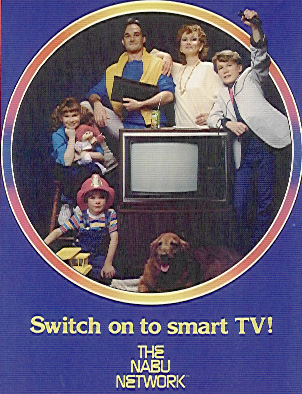
| . |  |
| Above: Promotional material published for the NABU computer network in 1984 targeted the whole family. (NABU Network Corporation) |
The NABU (Natural Access to Bidirectional Utilities) system provides an example of technology that did not succeed because society was not ready for it in 1982. Based on John Kelly's imaginative concept, it was the "Internet"- ten years ahead of its time (910391, 921242).
NABU, launched in Ottawa, was intended as a two-way system, providing many services including tele-banking, tele-shopping, electronic mail, home security, computer games, and a host of other applications including Canada's innovative Telidon1 (850382) system for interactive television. Users bought the hardware for $950-about the same as a Commodore 64 computer, or one-quarter the cost of a Macintosh Plus. They accessed programs via the cable TV network for $8 to $10 per month and viewed them on their television. The first programs available, about 100, were mostly games but included personal finance packages and consumer services. The host computer for the NABU Network was a DEC mainframe. The data transfer rate was a very fast 6.4 megabytes per second-information was instantly accessible. Most Internet users today just dream of such speeds! An optional hard drive could be purchased to store data for later use. A printer connected to a serial port.
In 1985 NABU went off-line, overtaken by the rapid rise in personal computer technology with its plethora of games and software options. Few expectations were met, as the NABU Network did not catch on due to lack of accessible resources. Another problem was the security of transmitted information, an issue only now being solved.
1
Closed captioning on television for the hearing impaired was developed for the Telidon system.Reprinted courtesy of the National Museum of Science and Technology